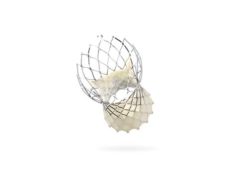
A subanalysis from the SURTAVI trial has found that transcatheter aortic valve implantation (TAVI) with Evolut R in intermediate-risk patients has lower rates of all-cause mortality or disabling stroke than surgical valve replacement 12 months after implantation. Steven J Yakubov (Riverside Methodist Hospital, Columbus, Ohio, USA) presented data from a propensity-score matched comparison at a late-breaking trial session at Cardiovascular Research Technologies (CRT) 2019 (2–5 March, Washington DC, USA). The findings have also been published in the Journal of American College of Cardiology: Cardiovascular Interventions.
He said: “All-cause mortality or disabling stroke, at one year, were less with TAVI compared to surgical aortic valve replacement. The transcatheter replacement group had less aortic valve or heart failure hospitalisations and less atrial fibrillation than the surgical replacement group at one year, and there was more need for permanent pacemaker implantation in the transcatheter group.”
The randomised SURTAVI trial demonstrated that TAVI using a self-expanding valve is non-inferior to surgical aortic valve replacement for the primary endpoint of all-cause mortality or disabling stroke at two years in patients at intermediate risk. Yakubov explained: “The Evolut R device was approved by the FDA as SURTAVI was enrolling patients; as a result, CoreValve was implanted in 84% of the patients in the transcatheter arm of the study, with only the remaining 16% receiving Evolut R. A continued access study was initiated after SURTAVI was fully enrolled to allow analysis of transcatheter implantation using the Evolut R device in intermediate-risk patients.”
The aim of the SURTAVI propensity score matched analysis was to compare one-year outcomes with Evolut R in intermediate-risk patients to those from a comparable surgical replacement cohort. Propensity matching on 22 variables allowed comparison between 197 Evolut R patients and 197 SURTAVI participants who underwent surgery. Average age was 79 years, and 40% of patients were male. Other matched variables included body mass index (BMI), New York Heart Association (NYHA) classification III/IV, need for revascularisation, peripheral vascular disease, and diabetes controlled by insulin.
At 12 months, combined all-cause mortality and disabling stroke on a Kaplan-Meier analysis were 4.1% (95% confidence interval [CI] 1.8–9.3) in the Evolut R patients vs. 8.2% (95% CI 5.1–13.1, p=0.08) among patients who had had surgery. Disabling stroke rates alone were 1% (95% CI 0.2–5.6) and 3.1% (95% CI 1.3–6.9, p=0.15), respectively, and there were less aortic valve hospitalisations using Evolute R (4.6% vs. 3.8% with surgery, p=0.33). In other clinical outcomes, the percentage of atrial fibrillation in patients receiving Evolute R was almost half that of those who underwent surgery (18.2% vs. 37.4%, p<0.01), and permanent pacemaker implantation rates were doubled (Evolut R 15.3%, surgery 7.8%, p=0.02).
Additionally, said Yakubov: “Evolut R demonstrated excellent haemodynamic performance. It had significantly better valve performance over surgery at all follow-up visits—baseline, discharge, six months, and one year [P<0.01].”
Among patients implanted with Evolut R, 61.2% experienced either no or trace aortic regurgitation (core lab adjudicated) and 32.9% had mild regurgitation; surgiwith 92% of surgical patients having no or trace regurgitation and 7.9% experiencing mild aortic regurgitation.
Evolut R also performed favourably on the outcomes of all-cause mortality and disabling stroke in a comparison of the propensity score matched analysis against the main SURTAVI trial—Evolut R 4.1% versus all TAVI 7.8% and all surgical replacement 8.5%.
Yakubov concluded: “The results for Evolut R TAVI were achieved compared to a propensity-score matched surgical group that had low STS [Society of Thoracic Surgery risk] scores. Advancements in catheter design technology may help drive greater success for intermediate-risk patients with severe, symptomatic aortic stenosis.”










